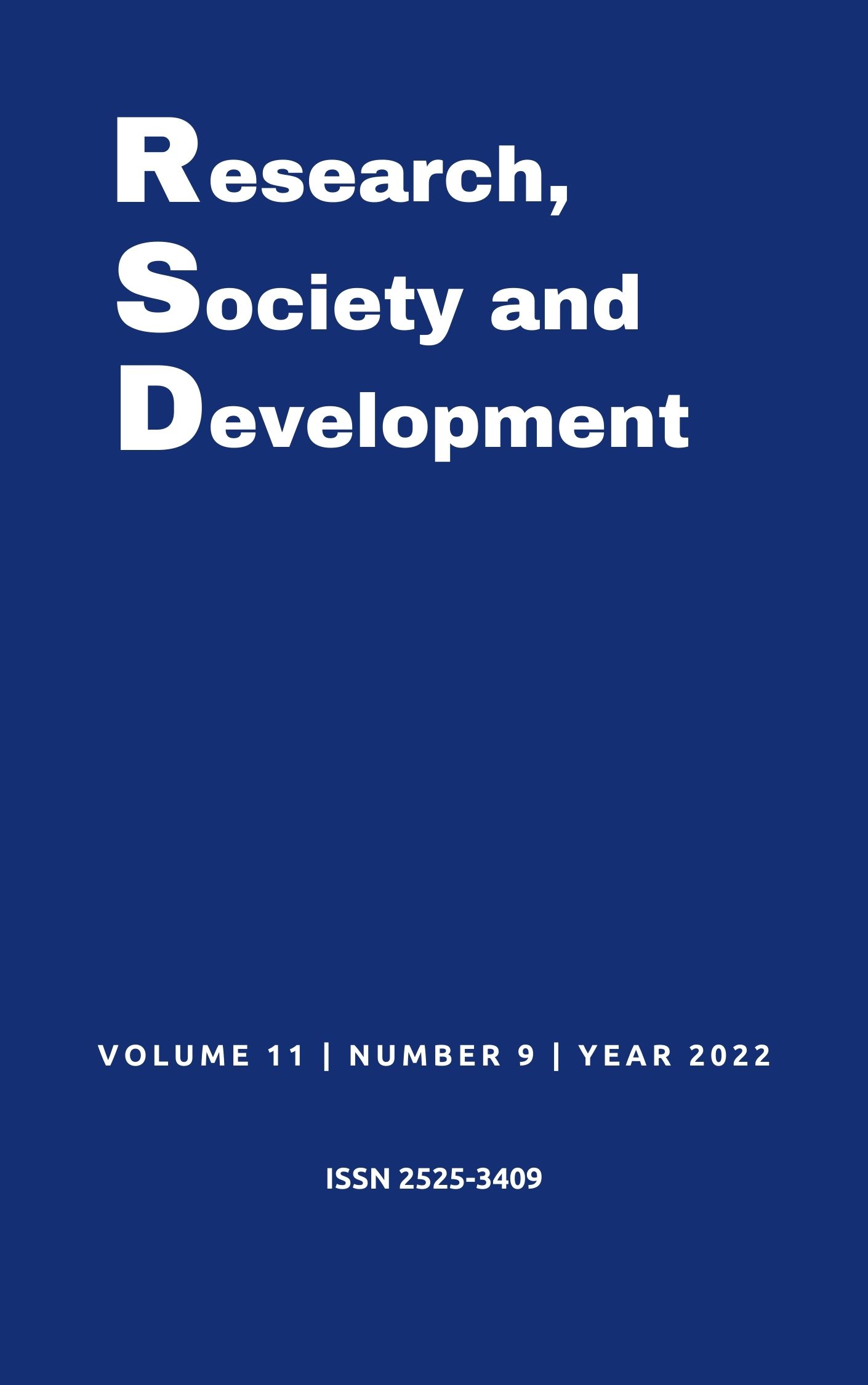Diagnóstico da leucemia linfoblástica aguda em crianças
DOI:
https://doi.org/10.33448/rsd-v11i9.19078Palavras-chave:
Cáncer, Diagnóstico, Leucemia, Classificação, Tratamento de LLA.Resumo
A leucemia linfóide ou linfoblástica aguda (LLA) infantil é decorrente do ataque às células linfóciticas do tipo B imaturos, resultante de danos genéticos adquiridos e não herdados, ocupando o primeiro lugar no ranking de incidência de doenças, segundo o instituto nacional do câncer (INCA). A melhoria nas técnicas de estudo proporciona agora a oportunidade de obter informações biológicas clinicamente relevantes que poderão explicar as respostas aparentemente anômalas ao tratamento. Este estudo teve como objetivo descrever as formas de diagnóstico úteis para a classificação e tratamento de Leucemia Linfoblástica Aguda em Crianças e apresentar as implicações das técnicas de citomorfologia, citogenética, imunofenotipagem e citoquímica no diagnóstico e prognóstico das leucemias. A revisão sistemática para elaboração deste consenso baseou-se preferencialmente em artigos indexados, publicados nos últimos dez anos fundamentados nos dados PubMed, Scielo, NCBI. Com os resultados foi possível perceber em relação ao hemograma, a contagem global de leucócitos na LLA em criançaspode estar diminuída, normal ou aumentada. Já no mielograma, o diagnóstico da LLA em crianças é confirmado quando mais de 25% a 30% das células nucleadas são blastos. De acordo com as colorações citoquimicas, diagnostica-se LLA quando se obtém uma prova positiva para as técnicas de PAS. Portanto, o conhecimento a cerca das formas de diagnóstico e da classificação da LLA em crianças é de suma importância para um diagnóstico precoce e com isso promover um tratamento eficaz.
Referências
ABRALE – Associação Brasileira de Linfoma e Leucemia. (2016).
Barbosa, C. M. P. L. et al. (2005). Manifestações Músculo-Esqueléticas como Apresentação Inicial das Leucemias Agudas na Infância. Jornal de Pediatria, Rio de Janeiro, vol. 81, n.3.
Cazé, M. O.; Bueno, D.; Santos, M. E. F. dos. (2010). Estudo Referencial de um Protocolo Quimioterápico para Leucemia Linfocítica Aguda Infantil. Rev. HCPA, Porto Alegre, vol.30, n.1, p.5-12.
Ecker, C. S. et al. (2009). Leucemia Linfóide Aguda: a importância do laboratório de líquor para o sucesso do tratamento. RBAC, Mato Grosso do Sul, vol.41, n.3, p. 201-203.
Farias, M. G.; Castro, S. M. de. (2005). Diagnóstico Laboratorial das Leucemias Linfóides Agudas. J. Bras. Patol. Med. Lab. Rio de Janeiro, vol.40, n.2.
Hoffbrand, A. V.; Moss P. A. H.; Pettit, J. E. (2008). Fundamentos em Hematologia. 5. ed. Porto Alegre: Artmed.
Hanna, L.M.O. (2014). Impacto do Câncer na Qualidade de Vida de CriançasSubmetidas ao Primeiro Ciclo de Quimioterapia, SÃO PAULO.
INCA – Instituto Nacional de Câncer José Alencar Gomes da Silva. (2016). Leucemia: prevenção, genética, outros fatores de risco.
Lamego, R. M. et al. (2010). Transplante alogênico de células-tronco hematopoéticas em leucemias agudas: a experiência de dez anos do hospital das clínicas da UFMG. Revista Brasileira de Hematologia e Hemoterapia, vol.32, n.2, p.108-115.
Merck, S. D. (2010). Manual Merck de Informação Médica-Saúde para a Família. Seção 14 Distúrbios do Sangue, cap. 157 Leucemias. 2ª ed., Brasil: ROCA.
Marconi, M. de A., LAKATOS, Eva M. (2005). Fundamentos de Metodologia Científica. 6ªed. São Paulo: Atlas S. A.
Oliveira, B. M. de. et al. (2005). Avaliação da Adesão ao Tratamento através de Questionários: estudo prospectivo de 73 crianças portadoras de leucemia linfoblástica aguda. Jornal de Pediatria, Rio de Janeiro, vol. 81, n.3.
Pinheiro, S. M. et al. (2010). Alterações Metabólicas em Crianças com Câncer Hematológico Submetidas ao Transplante de Medula Óssea Alogênico.Rev. Bras. Hematol. Hemoter, Rio de Janeiro, vol. 27, p.261-70.
Quixabeira, V. B. L., Saddi, V. A. (2008). A Importância da Imunofenotipagem e da Citogenética no Diagnóstico das Leucemias: uma revisão de literatura.RBAC, vol. 40, n.3, p.199-202.
Rodrigues, F. A. et al. (2010). Diagnóstico Laboratorial de Leucemia Linfóide Aguda no Período de Janeiro a dezembro de 2003 no Centro de Hematologia de São Paulo.Rev. HCPA, São Paulo, vol.30, n.1, p.5-12.
SANTANA, L. R. et al. (2006). Perfil Epidemiológico das Leucemias em Crianças e Adolescentes no Estado da Bahia. Gazeta médica da Bahia, vol.76, n.3, p.51 – 54.
Seber, A. (2010). Transplante de Células-Tronco Hematopoéticas em Crianças e Adolescentes com Leucemias Agudas. Rev. Bras. Hematol. Hemoter. São Paulo, vol.32, n.5.
SILVA, P. H; HASHIMOTO, Y; ALVES, H. B. (2009). Hematologia Laboratorial. Rio de Janeiro: Revinter.
Silveira, N. A., Arraes, S. M. A. A. (2008). A Imunofenotipagem no Diagnóstico Diferencial das Leucemias Agudas: uma revisão. Arq. Mudi., vol.12, n.1, p.5-14.
Texeira, J. E. C. (2006). Diagnóstico Laboratorial em Hematologia. 1ª ed. São Paulo: ROCA.
Downloads
Publicado
Edição
Seção
Licença
Copyright (c) 2022 Jadielson da Silva Santos; Luiz Fernando Pereira de Sá; João Paulo de Oliveira Mata; Atílio da Silva Teixeira ; Antonio Vinícius Sales de Moraes Souza Crisanto; Gabriela Rodrigues Amorim; Flávia Piauilino Pinheiro; Luana Amorim Guilhon; Ícaro Avelino Silva; Gabriel Franco de Sousa; Larissa dos Santos Pessoa; Maria Pereira de Queiroga Aguiar; Ulisses Nogueira de Aguiar; Amanda Miranda da Silva; Walquer Vinicius Esteves Gonçalves

Este trabalho está licenciado sob uma licença Creative Commons Attribution 4.0 International License.
Autores que publicam nesta revista concordam com os seguintes termos:
1) Autores mantém os direitos autorais e concedem à revista o direito de primeira publicação, com o trabalho simultaneamente licenciado sob a Licença Creative Commons Attribution que permite o compartilhamento do trabalho com reconhecimento da autoria e publicação inicial nesta revista.
2) Autores têm autorização para assumir contratos adicionais separadamente, para distribuição não-exclusiva da versão do trabalho publicada nesta revista (ex.: publicar em repositório institucional ou como capítulo de livro), com reconhecimento de autoria e publicação inicial nesta revista.
3) Autores têm permissão e são estimulados a publicar e distribuir seu trabalho online (ex.: em repositórios institucionais ou na sua página pessoal) a qualquer ponto antes ou durante o processo editorial, já que isso pode gerar alterações produtivas, bem como aumentar o impacto e a citação do trabalho publicado.


